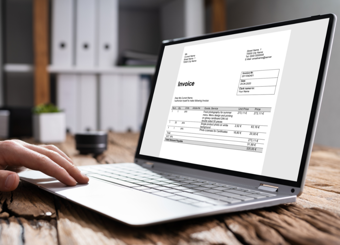Accounts payable glossary - key terms for AP professionals
Learning the lingo is the first step toward success in accounts payable. The talk of the trade includes specific accounts payable terminology all AP professionals should know. A glossary of key terms is also useful for the finance team and the C-suite. Reviewing the fundamental vocabulary helps everyone gain a better understanding of the operations and goals of the AP team, as well as the role AP automation plays in accomplishing them.
The first section of this comprehensive accounts payable glossary focuses on the preliminary terms everyone in accounting should recognize and understand. The second section is devoted specifically to accounts payable terminology.
Basic Glossary Terms
Asset - an economic resource with anticipated benefits in the future, based on past events or transactions. An asset is anything of value to which the organization has a legal claim, including tangible and intangible objects of economic value.
- Current assets - will convert to cash within one year, such as inventory, accounts receivable, or cash.
- Fixed assets - long-term that may provide benefits to the organization for over a year, such as equipment, real estate, large machines or land.
Balance sheet - a summary financial report stating the organization’s assets, liabilities, and shareholder or owner equity at the time of the report. Assets = Liabilities + Equity
Capital – wealth in the form of assets or cash that show the financial strength of the organization, and the money can be used for development or investment in a business to generate income.
Cash flow – the incoming and outgoing of cash disbursements and receipts which represent the operating activities of a company. Cash flow represents the difference in the amount of cash available at the start of a period (opening balance) and the amount at the closing of the period (closing balance). When the closing balance is higher than the opening balance, it is called positive, and the reverse is negative.
Cost of goods sold – the figure that represents the cost of purchasing raw materials used to produce the finished goods being sold by a business. In retail, the cost of goods sold is the purchase price of the merchandise. It can also be referred to as the cost of sales.
Diversification – diversification occurs when a business enters a market or industry different from its core enterprise to reduce the risk of relying on a singular source, avoid seasonal or fluctuations and cyclical demand cycles, become more competitive with related industry, and promote a faster growth rate of the organization.
Expenses – costs incurred or money spent on a company's efforts to earn revenue, which represent the cost of conducting business.
- Fixed expenses – costs that are constant in a defined time period, volume, or range of activity. Non-cash items are not included, such as depletion and depreciation.
- Variable expenses – a cost that changes in proportion to the changes in measures of volume or productive output, which can be traced to specific expenses such as product, process, or department. Also known as variable cost and direct expense.
- Accrued expenses – expenses that occur but no payment is made during an accounting period, such as utility charges and wages. These expenses are shown as current (short-term) liabilities in the balance sheet and may also be referred to as accrued liabilities.
General ledger – the central repository of all liability, asset, revenue, owners equity, and expense accounts of an organization that summarizes all financial transactions from subsidiary ledgers during a specific accounting period. The general ledger also referred to as the book of final entry, offers all the data used to prepare financial statements for the company.
P&L – formally known as a profit and loss statement, is the financial statement summarizing costs, expenses, and revenues for a specific period of time, typically a year or fiscal quarter. Like the income statement, the P&L shows an organization's ability or inability to generate provide by reducing costs, increasing revenue or both. The P&L statement is also referred to as a statement of operations or earnings statement.
Net income – the excess or deficit of total gains and revenues as compared with total losses and expenses for an organization during a specific accounting period. Also referred to as earnings, net profit, and net earnings.
ERP – ERP, which stands for enterprise resource planning, refers to the integrated management of the core business process, usually in real-time and handled via updated technologies and software. The technologies provide financial intelligence, analytics, and visibility. Think about all the core processes needed to run a company: finance, HR, manufacturing, supply chain, services, procurement, and others. At its most basic level, ERP integrates these processes into a single system. This way, ERP systems track business resources—cash, raw materials, production capacity—and the status of business commitments: orders, purchase orders, and payroll.
AP Specific Terminology
AP specific terms help the accounts payable department gain greater focus on its operations and what they mean to the organization in its entirety.
Invoice data capture - scanning software is used for invoice data capture so suppliers can submit invoices digitally, or in their chosen format, and an organization can digitize and import the data into a uniform format, eliminating the need to enter invoice information manually. The result is a paperless accounts payable process with improved data quality by reducing the risk of data entry errors. Capture software may be used to validate invoice details per an organization's pre-defined rules or requirements.
E-invoice – formally referred to as an electronic invoice, an e-invoice is sent electronically via the Internet and can be integrated into the organization, supplier, and/or customer's accounts payable system The integrated electronic invoice document is typically between a buyer and supplier, and eliminates the need for paper-based invoices.
Invoice/AP workflow – collection and reconciliation of invoices, purchase orders, and approvals within an organization by the AP department. Invoices must be matched, approved, and validated for payment and reconciliation. AP automation solutions automatically handle these tasks to eliminate the delays and bottlenecks associated with manual invoice processing. AP automation also enhances the visibility of the process and as such, an organization's ability to support spend analytics and audits.
Invoice matching – the comparing and linking of a supplier invoice with the underlying data on which the cost is based, such as a contract or purchase order and goods delivery receipt (GDR). Matching invoices manually is time-consuming, especially on a line-level where each invoice row needs to be connected, sometimes to multiple purchase orders, and verified. AP invoice automation handles a significant portion of the invoice matching in an automatic workflow, using intelligent matching technology and pre-set business rules. Deviations are automatically identified and send to specific personnel for review and a decision.
Purchase order - also referred to as a PO, a purchase order is a document generated by a buyer that authorizes a purchase transaction. When the seller accepts the PO, it becomes a binding contract on both parties that outlines the descriptions, prices, quantities, discounts, payment terms, date of shipment or performance, and other terms and conditions related to the transaction between the buyer and a named seller.
Exception/deviation – a situation where the invoice data deviates from the contractual document, purchase order, or goods delivery receipt associated with the purchase. Deviations may occur when the unit cost of goods is different from what is stated on the purchase order (price deviation) or when the number of goods invoiced does not match the number delivered and reported on the GDR (quantity deviation). In these cases, the relevant individual in the buying organization will need to investigate the reason for the deviation. When an AP automation solution is in place the system can identify the deviating invoice rows and automatically send a notification to the buyer for further investigation.
Days payment outstanding (DPO) – an organization's average payable period that measures the length of time it takes for a company to pay its invoices from suppliers and other trade creditors. DPO is also referred to as the number of days payable.
Touchless invoice processing – no manual input is necessary from the time the invoice arrives at an organization to the time it is posted to the ERP for final booking and payment. Touchless invoice processing is possible when the invoice is automatically matched against a supporting document, such as a goods receipt and purchase order or contract, and sent for payment without any human handling.
With this accounts payable glossary AP professionals from the AP department to the C-suite can gain insight into the typical accounts payable terminology associated with everyday operations. And remember to bookmark this page as we will add more relevant terms on a regular basis, including the latest AP automation terminology.






